Deprotonation Study guides, Class notes & Summaries
Looking for the best study guides, study notes and summaries about Deprotonation? On this page you'll find 40 study documents about Deprotonation.
All 40 results
Sort by
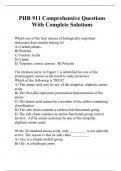
-
PHR 911 Comprehensive Questions With Complete Solutions
- Exam (elaborations) • 28 pages • 2023
-
Available in package deal
-
- $12.99
- + learn more
Which one of the four classes of biologically important molecules does insulin belong to? A) Carbohydrates B) Proteins C) Nucleic Acids D) Lipids E) Terpenes correct answer: B) Proteins The titration curve in Figure 1 is identified for one of the proteinogenic amino acids (used to make proteins): Which of the following is TRUE? A) The amino acid may be any of the nonpolar, aliphatic amino acids B) The first pKa represents protonation/deprotonation of the amine C) The amino acid cann...
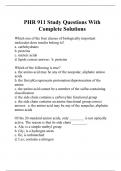
-
PHR 911 Study Questions With Complete Solutions
- Exam (elaborations) • 12 pages • 2023
-
Available in package deal
-
- $10.99
- + learn more
Which one of the four classes of biologically important molecules does insulin belong to? a. carbohydrates b. proteins c. nucleic acids d. lipids correct answer: b. proteins Which of the following is true? a. the amino acid may be any of the nonpolar, aliphatic amino acids b. the first pKa represents protonation/deprotonation of the amine c. the amino acid cannot be a member of the sulfur-containing classification d. the side chain contains a carboxylate functional group e. the sid...
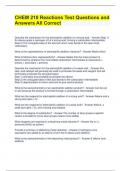
-
CHEM 210 Reactions Test Questions and Answers All Correct
- Exam (elaborations) • 3 pages • 2024
-
Available in package deal
-
- $12.99
- + learn more
CHEM 210 Reactions Test Questions and Answers All Correct Describe the mechanism for the electrophilic addition of a strong acid. - Answer-Step 1) An alkene grabs a hydrogen off of a strong acid, forming a carbocation intermediate. Step 2) The conjugate base of the acid (an anion now) bonds to the open shell carbocation What is the regioselectivity of electrophilic addition reactions? - Answer-Markovnikov What is Markovnikov regioselectivity? - Answer-States that the major product is det...

-
Chem 210 Exam 3 questions and answers
- Exam (elaborations) • 11 pages • 2023
-
Available in package deal
-
- $14.99
- + learn more
what factors explain the outcomes of reactions? hybridization, delocalization, eN, atom density what is a leaving group? - group of atom(s) that can be stable on its own - eN atoms that are good LG also make strong acids what is the α carbon? C directly attached to leaving group what are β Cs? β Hs? βC: C(s) attached to α carbon βH: H(s) attached to βC what is a LB? is it a nucleophile or electrophile? lewis base, nucleophile what is nucleophilic ...

-
BCHE 5180 / 6180 FINAL EXAM | Graded A
- Exam (elaborations) • 18 pages • 2023
-
Available in package deal
-
- $13.99
- + learn more
BCHE 5180 / 6180 FINAL EXAM | Graded A.Based on what you have learned about the functioning of enzymes and proteins, explain why the pH in the cell has to be buffered. A large group of enzymes show a pH optimum for their activity. This value is normally close to the pH in the cell. When the pH in the cell changes this can lead to a protonation or deprotonation of an amino acid that is important for the enzymatic activity. As a result the activity will decrease. Upon large changes in pH add...

-
BCHE 5180 / 6180 FINAL EXAM | Graded A.
- Exam (elaborations) • 18 pages • 2023
-
- $13.99
- + learn more
BCHE 5180 / 6180 FINAL EXAM | Graded A.Based on what you have learned about the functioning of enzymes and proteins, explain why the pH in the cell has to be buffered. A large group of enzymes show a pH optimum for their activity. This value is normally close to the pH in the cell. When the pH in the cell changes this can lead to a protonation or deprotonation of an amino acid that is important for the enzymatic activity. As a result the activity will decrease. Upon large changes in pH add...
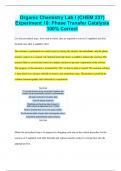
-
Organic Chemistry Lab I (CHEM 237) Experiment 10: Phase Transfer Catalysis 100% Correct
- Exam (elaborations) • 5 pages • 2023
- Available in package deal
-
- $8.99
- + learn more
Organic Chemistry Lab I (CHEM 237) Experiment 10: Phase Transfer Catalysis 100% Correct List the procedural steps, from start to finish, that are required to convert 2-naphthol and allyl bromide into allyl 2-naphthyl ether. The reaction is performed on a small scale by mixing the alcohol, the haloalkane, and the phase transfer catalyst in a conical vial. Sodium hydoxide (base) is added to initiate the reaction. The reaction flask is covered and stirred to conduct reaction to prevent evaporation...

-
BCHE 5180 / 6180 FINAL EXAM | Graded A
- Exam (elaborations) • 18 pages • 2023
-
- $13.99
- + learn more
BCHE 5180 / 6180 FINAL EXAM | Graded A.Based on what you have learned about the functioning of enzymes and proteins, explain why the pH in the cell has to be buffered. A large group of enzymes show a pH optimum for their activity. This value is normally close to the pH in the cell. When the pH in the cell changes this can lead to a protonation or deprotonation of an amino acid that is important for the enzymatic activity. As a result the activity will decrease. Upon large changes in pH add...
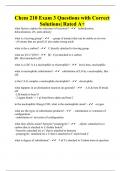
-
Chem 210 Exam 3 Questions with Correct Solutions| Rated A+
- Exam (elaborations) • 9 pages • 2023
-
Available in package deal
-
- $10.99
- + learn more
what factors explain the outcomes of reactions? - hybridization, delocalization, eN, atom density what is a leaving group? - - group of atom(s) that can be stable on its own - eN atoms that are good LG also make strong acids what is the α carbon? - C directly attached to leaving group what are β Cs? β Hs? - βC: C(s) attached to α carbon βH: H(s) attached to βC what is a LB? is it a nucleophile or electrophile? - lewis base, nucleophile what is nucleophilic ...

-
BCHE 5180 / 6180 FINAL EXAM | Graded A
- Exam (elaborations) • 18 pages • 2023
-
- $13.99
- + learn more
BCHE 5180 / 6180 FINAL EXAM | Graded A.Based on what you have learned about the functioning of enzymes and proteins, explain why the pH in the cell has to be buffered. A large group of enzymes show a pH optimum for their activity. This value is normally close to the pH in the cell. When the pH in the cell changes this can lead to a protonation or deprotonation of an amino acid that is important for the enzymatic activity. As a result the activity will decrease. Upon large changes in pH add...

How much did you already spend on Stuvia? Imagine there are plenty more of you out there paying for study notes, but this time YOU are the seller. Ka-ching! Discover all about earning on Stuvia


